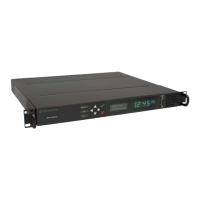3.
The 10 MHz edit window will display. Choose a value from the Signature Control field
drop-down list to determine what SecureSync shall do with the output signal in the event its
input reference is lost. For more information, see "Signature Control" below.
4.
Click Submit.
2.16.3 Configuring Optional Outputs
Next to the standard outputs, optional outputs e.g., ASCII or IRIG, are available through
Option Cards.
The functionality and configuration of these options are documented under "Option Cards" on
page345.
2.16.4 Network Ports
The Network Ports can be configured under MANAGEMENT > Network Setup. For more inform-
ation, see "Configuring Network Settings" on page55.
2.16.5 Signature Control
Signature Control is a user-set parameter that controls under which output states an output will
be present. This feature allows you to determine how closely you want to link an output to the
status of the active input reference e.g., by deactivating it after holdover expiration. It is also
offers the capability to indirectly send an input-reference-lost-alarm to a downstream recipient
via the presence of the signal.
E X A M P L E S :
You can setup Signature Control such that SecureSync's built in 1PPS output becomes disabled the
moment its input reference is lost (e.g., if a valid GNSS signal is lost).
Or, you can setup your output signal such that remains valid while SecureSync in holdover mode, but
not in free run.
The available options are:
I.
Output Always Enabled—The output is present, even if SecureSync is not synchronized to
its references (SecureSync is free running).
2.16 Configuring Outputs
CHAPTER 2 • SecureSync User Reference Guide Rev. 26
141

